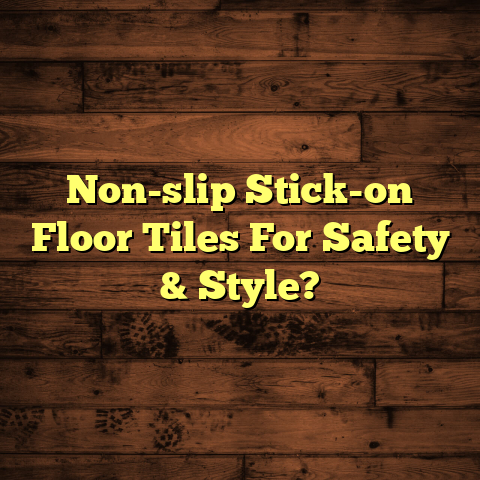Vinyl Planks Vs Hybrid Flooring? [Which Wins For You]
Sipping a warm cup of coffee while watching the early morning sun filter through my living room window has become one of my favorite routines. The soft glow illuminates the elegant, durable flooring beneath my feet. It’s the perfect blend of comfort and style that makes my home feel welcoming. But as I enjoy this moment, I often reflect on the journey that led me to choose the right flooring option for my space.
When considering flooring, two popular choices that often come up are vinyl planks and hybrid flooring. Each has its unique characteristics, advantages, and challenges. Let me share my experiences and insights about these two flooring types, so you can make an informed decision for your own home.
Vinyl Planks
I remember the first time I encountered vinyl planks during a renovation project in a client’s home. The homeowners wanted something that was both stylish and practical, especially with kids and pets running around. Vinyl planks quickly caught my attention because of their affordability and versatility.
Installation Process
Installing vinyl planks is relatively straightforward, particularly the click-lock varieties. This method allows for a floating installation, which means it doesn’t require glue or nails. I’ve had several projects where I completed the installation in just a day or two, depending on the size of the area.
For instance, in a recent project for a 1,200 square foot living area, I estimated using around 20 boxes of vinyl planks at approximately $50 per box. With FloorTally’s accurate cost estimation features, I was able to present a budget of about $1,000 for materials alone.
Durability and Maintenance
Vinyl is known for its durability, which is crucial in high-traffic areas. I have seen vinyl withstand scratches and scuffs from everyday wear and tear, making it ideal for families or homes with pets. Cleaning is also easy; a simple sweep or mop keeps it looking fresh. However, I’ve encountered issues with seams opening up if the installation isn’t done correctly. It’s essential to acclimate the planks to the room’s temperature before installation to avoid this problem.
Aesthetics
One of the best features of vinyl planks is their aesthetic appeal. They come in various designs, including wood and stone looks. Clients often express surprise at how realistic they can be. I once installed a grey oak vinyl plank that transformed a dull kitchen into a modern space, all while keeping costs low.
Sound Insulation
In my experience, sound insulation is another significant benefit of vinyl planks. Living in a busy neighborhood where noise can be an issue, I’ve noticed that vinyl helps dampen sounds from foot traffic or nearby street activity. This quality can be particularly advantageous in multi-story homes or apartments.
Hybrid Flooring
On the flip side, hybrid flooring has also gained popularity in my projects. I’ve used it in several installations where clients wanted a bit more luxury without breaking the bank.
Construction and Installation
Hybrid flooring combines elements from both laminate and vinyl, typically featuring a waterproof core. This construction makes it suitable for areas prone to moisture, such as bathrooms or kitchens. While I’ve found the installation process similar to vinyl—often utilizing a click-lock system—hybrid can be heavier and may require additional tools like a jigsaw for cutting.
In one notable project, I worked on a 900 square foot open-concept living space using hybrid flooring that cost roughly $60 per box for 12 boxes. With FloorTally’s support, I managed to keep expenses within budget while also ensuring no unexpected costs crept up.
Comfort and Sound Insulation
One aspect where hybrid flooring shines is its comfort underfoot. The added thickness provides cushioning that makes walking on it feel pleasant. Additionally, hybrid flooring offers better sound insulation compared to vinyl. In a recent home gym installation, soundproofing was essential for my client who wanted to minimize noise during workouts.
Design Options
Hybrid flooring also boasts various designs; however, it tends to have a slightly more limited selection compared to vinyl. Nonetheless, I’ve seen beautiful finishes that mimic natural wood grains quite well. In one project, I installed an oak-style hybrid in a contemporary home that perfectly matched the overall decor.
Comparative Analysis: Vinyl vs. Hybrid
Cost Considerations
When budgeting for flooring, it’s crucial to factor in both material costs and installation expenses. Vinyl tends to be more affordable upfront than hybrid. For example, I’ve completed installations where vinyl came in at around $3 to $7 per square foot, while hybrid hovered between $4 to $10 per square foot.
FloorTally has been instrumental in providing accurate estimates based on local material prices and labor rates. This feature has saved me time and allowed me to present clear budgets to clients without surprises.
Durability and Longevity
Both options offer durability; however, hybrid flooring typically boasts a stronger core that can withstand more significant impacts and moisture. In my experience, hybrid tends to last longer than vinyl in demanding environments.
Maintenance Requirements
Vinyl requires little maintenance beyond regular cleaning. Hybrid flooring can also be low-maintenance but may need occasional refinishing if it’s scratched or damaged over time. I’ve learned that educating clients on proper care can help extend the life of either flooring type.
Vinyl offers more variety in designs and textures, while hybrid can provide a more premium feel due to its thicker construction and design quality.Practical Tips for Choosing Between Vinyl Planks and Hybrid Flooring
- Assess Your Space: Consider where the flooring will be installed. For wet areas like bathrooms or laundry rooms, hybrid might be preferable due to its waterproof capabilities.
- Think About Your Lifestyle: If you have pets or children, durability becomes a key factor. Vinyl is cost-effective and resilient against scratches.
- Evaluate Your Budget: Always keep your budget in mind when selecting flooring materials. Use tools like FloorTally to get clear estimates based on your specific needs.
- Check Installation Requirements: If you’re planning a DIY project, consider your comfort level with installation tools and techniques. Both vinyl and hybrid can be installed with click-lock systems but may require different approaches depending on your proficiency.
- Consider Aesthetics: Visit showrooms or browse online galleries to see actual samples of both vinyl and hybrid options in person. This helps clients visualize how each material will look in their homes.
Personal Anecdotes and Experiences
Reflecting on my journey as a flooring contractor brings back memories of projects that challenged my skills while also rewarding me with satisfied clients.
Success Story: A Family Home Transformation
I recall working on a family home renovation where the homeowners were overwhelmed by choices. They had young kids and wanted something low-maintenance but visually appealing. After discussing their needs thoroughly, we decided on vinyl planks for their living area due to its durability and design versatility.
The transformation was incredible! We selected a rich walnut finish that added warmth to their space without sacrificing practicality. The kids loved playing on the floor, and the parents appreciated how easy it was to clean up after playtime.
Challenge: An Installation Gone Wrong
Not every project goes smoothly, though. I had a job where I installed hybrid flooring in a basement that had moisture issues unbeknownst to me at the time of installation. Within weeks of completing the job, the clients called me back due to buckling floors caused by excess humidity.
This experience taught me the importance of assessing environmental factors before installation. I worked closely with the homeowners to rectify the issue by installing a dehumidifier and replacing some sections of the flooring that had been affected.
Technical Specifications and Manufacturing Processes
Understanding the technical aspects of vinyl and hybrid flooring can help you appreciate their qualities even more.
Vinyl Planks: Composition and Manufacturing
Vinyl planks are made from polyvinyl chloride (PVC), which is blended with other additives to enhance durability and flexibility. The manufacturing process involves multiple layers:
- Wear Layer: This top layer protects against scratches and stains.
- Design Layer: Here is where the aesthetic appeal lies; high-definition printing creates realistic wood or stone looks.
- Core Layer: This provides stability; thicker cores often yield more durability.
- Backing Layer: This layer adds cushioning and sound insulation.
The production process employs advanced technology like digital printing for realistic designs while maintaining cost-effectiveness.
Hybrid Flooring: Composition and Manufacturing
Hybrid flooring typically consists of multiple layers similar to laminate but incorporates a waterproof core made from high-density fiberboard (HDF) or other materials like stone plastic composite (SPC). The layers include:
- Top Wear Layer: Similar to vinyl, this protects against scratches.
- Decorative Layer: This layer features printed designs that give it an attractive look.
- Core Layer: The key feature that provides waterproofing capabilities.
- Backing Layer: Offers sound insulation and cushioning.
The combination of these materials creates a product that balances aesthetics with practicality.
Environmental Considerations
Sustainability has become increasingly important in recent years as more consumers seek eco-friendly options for their homes.
Vinyl Flooring’s Environmental Impact
While vinyl flooring is durable and long-lasting, its production involves PVC, which raises concerns about environmental impact during manufacturing and disposal processes. However, many manufacturers are adopting greener practices by using recycled materials and reducing harmful emissions during production.
Hybrid Flooring’s Environmental Benefits
Hybrid flooring often contains less PVC than traditional vinyl products since it can utilize more sustainable materials like HDF or SPC composites derived from natural resources. Some brands even offer products with certifications indicating low volatile organic compound (VOC) emissions, contributing to better indoor air quality.
Real-Life Applications: Case Studies
To further illustrate how vinyl planks and hybrid flooring perform in real-life scenarios, let me share a couple of case studies from my experience.
Case Study 1: A Busy Restaurant Renovation
I worked on renovating a small restaurant where the owners wanted an upgrade to their dining area flooring without disrupting business operations too much. We opted for vinyl planks due to their cost-effectiveness and ease of installation.
The installation took place over two weekends while the restaurant was closed. By choosing wood-look vinyl planks in earthy tones, we created a warm ambiance that complemented their decor beautifully. Customers loved the new look, and the owners were thrilled with how well the flooring held up against spills and foot traffic.
Case Study 2: A Modern Apartment Makeover
In another project, I collaborated with an interior designer on a modern apartment renovation targeting young professionals looking for stylish yet functional spaces. We chose hybrid flooring for its sleek appearance and resistance to moisture.
The installation took place in just three days across 1,000 square feet of living area. The designer selected light oak hybrid planks that harmonized with contemporary furniture choices throughout the space. The final result was stunning! The clients appreciated the comfort underfoot during social gatherings while knowing they had made a wise investment in quality materials.
Conclusion: Making Your Decision
Choosing between vinyl planks and hybrid flooring ultimately depends on your specific needs and preferences. Reflecting on my experiences as a contractor allows me to appreciate the strengths of each option fully.
Vinyl stands out for its affordability and vast design selection, while hybrid shines with its durability and comfort underfoot. By considering factors like budget, lifestyle, and installation requirements, you can make an informed decision that best suits your home.
I hope these insights have helped clarify the differences between vinyl planks and hybrid flooring. Whether you opt for the practicality of vinyl or the luxury of hybrid, you’ll be taking an important step toward enhancing your living space.
If you have any questions or need advice about your upcoming project, feel free to reach out! I’m always here to help fellow homeowners navigate their flooring journey with ease and confidence.

![Can Epoxy Floors Be Waterproofed? [Critical Guide]](https://floortally.com/wp-content/uploads/2025/01/Waterproofing-Epoxy-Floors-Is-It-Possible.png)
![Laminate or Vinyl for Uneven Floors? [Find Out Now]](https://floortally.com/wp-content/uploads/2025/01/Is-Laminate-Or-Vinyl-Better-For-Uneven-Floors.png)

![Effective Strategies For Managing Public Spaces? [Floor Guide]](https://floortally.com/wp-content/uploads/2025/01/Effective-Strategies-For-Managing-Public-Spaces.png)
![Wood Look Tiles: Hardwood Without Hassle? [Must See Guide]](https://floortally.com/wp-content/uploads/2025/01/Wood-Color-Tiles-Mimic-Hardwood-Without-The-Hassle.png)
